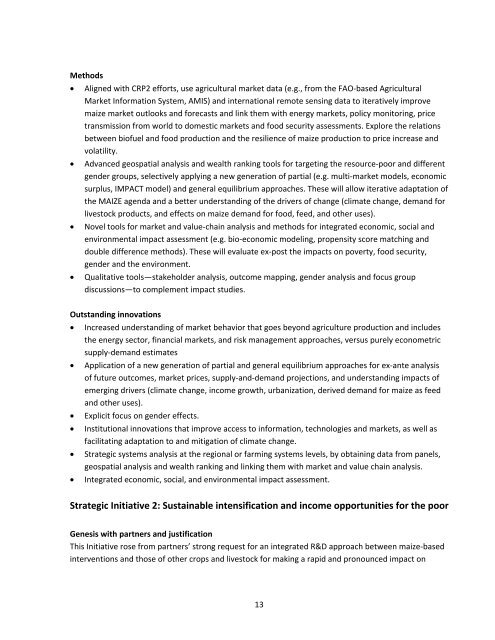Download - Maize
Download - Maize
Download - Maize
Create successful ePaper yourself
Turn your PDF publications into a flip-book with our unique Google optimized e-Paper software.
Methods<br />
Aligned with CRP2 efforts, use agricultural market data (e.g., from the FAO‐based Agricultural<br />
Market Information System, AMIS) and international remote sensing data to iteratively improve<br />
maize market outlooks and forecasts and link them with energy markets, policy monitoring, price<br />
transmission from world to domestic markets and food security assessments. Explore the relations<br />
between biofuel and food production and the resilience of maize production to price increase and<br />
volatility.<br />
Advanced geospatial analysis and wealth ranking tools for targeting the resource‐poor and different<br />
gender groups, selectively applying a new generation of partial (e.g. multi‐market models, economic<br />
surplus, IMPACT model) and general equilibrium approaches. These will allow iterative adaptation of<br />
the MAIZE agenda and a better understanding of the drivers of change (climate change, demand for<br />
livestock products, and effects on maize demand for food, feed, and other uses).<br />
Novel tools for market and value‐chain analysis and methods for integrated economic, social and<br />
environmental impact assessment (e.g. bio‐economic modeling, propensity score matching and<br />
double difference methods). These will evaluate ex‐post the impacts on poverty, food security,<br />
gender and the environment.<br />
Qualitative tools—stakeholder analysis, outcome mapping, gender analysis and focus group<br />
discussions—to complement impact studies.<br />
Outstanding innovations<br />
Increased understanding of market behavior that goes beyond agriculture production and includes<br />
the energy sector, financial markets, and risk management approaches, versus purely econometric<br />
supply‐demand estimates<br />
Application of a new generation of partial and general equilibrium approaches for ex‐ante analysis<br />
of future outcomes, market prices, supply‐and‐demand projections, and understanding impacts of<br />
emerging drivers (climate change, income growth, urbanization, derived demand for maize as feed<br />
and other uses).<br />
Explicit focus on gender effects.<br />
Institutional innovations that improve access to information, technologies and markets, as well as<br />
facilitating adaptation to and mitigation of climate change.<br />
Strategic systems analysis at the regional or farming systems levels, by obtaining data from panels,<br />
geospatial analysis and wealth ranking and linking them with market and value chain analysis.<br />
Integrated economic, social, and environmental impact assessment.<br />
Strategic Initiative 2: Sustainable intensification and income opportunities for the poor<br />
Genesis with partners and justification<br />
This Initiative rose from partners’ strong request for an integrated R&D approach between maize‐based<br />
interventions and those of other crops and livestock for making a rapid and pronounced impact on<br />
13

















